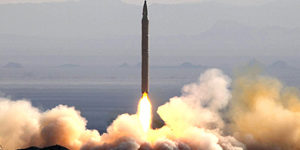Facts
| Designation | Qiam-1 |
| Missile Variants | Upgraded Shahab-2 |
| Mobility | Road-Mobile |
| Designer/Producer | Iran |
| Range | 800KM |
| Warhead Type and Weight | Unknown, 750 kg |
| MIRV and Yield | MRV Capable |
| Guidance System/ Accuracy | Unknown/ 500 CEP |
| Stages/ Propellant | Single/ Liquid Propellant |
| IOC | Unknown |
| Status/ Number of Units | Operational/ Unknown |
Development
The Qiam is a short range ballistic missile produced by Iran. Declared operational in 2010, the Qiam has a reported range of approximately 800km (497 miles), is liquid fueled, and carries a payload of 746kg. [1] The missile is purportedly based of the design of the Shahab-2, but does not include stabilizer fins as to reduce the Qiam’s radar signature and allow for higher velocities during reentry. As a road mobile system, the missile can be fired from any location. According to Iranian officials, the Qiam is equipped with multi-reentry vehicle warheads (MRV). [2] The missile’s MRV capability enables it to evade missiles fired from missile defense shields.
Strategic Implications
According to Iranian officials, the Qiam was specifically built to target US bases in the Middle East, which have “encircled Iran.” [3] With military bases in Saudi Arabia, Bahrain, and Qatar, US military installations serve to surveillance Iran. The Qiam, with a range of 800km (497 miles), can hold these countries and U.S. military installations near its borders at risk. Furthermore, the Qiam’s road mobility makes it easy to conceal and therefore more resilient to a preemptive strike. Iran has been steadily supplying the Houthi rebels of Yemen with Qiam missiles in their fight against Saudi Arabia, their range proving capable of targeting Saudi oil fields and other important locations. The Qiam missile is also able to be equipped with a nuclear warhead, hence the fear surrounding the spread of such a weapon by a state to rebels in a region often found to be unstable. [4]
[1] “Iran announces missile breakthrough.” Al Jazeera, March 5, 2014. Accessed April 8, 2014.
[2] “Iran Equips Qadr H, Qiam Ballistic Missiles with MRV Payloads.” Fars News Agency (Tehran), March 5, 2014. Accessed April 8, 2014.
[3] Ben, Piven “Map: US bases encircle Iran.” Al Jazeera (Doha, Qatar), May 1, 2012. Accessed April 8, 2014. http://www.aljazeera.com/indepth/interactive/2012/04/2012417131242767298.html.
[4] Talley, Ian. “U.S. Widens Iran Sanctions for Supplying Missiles to Yemen’s Houthis.” The Wall Street Journal, Dow Jones & Company, 22 May 2018, www.wsj.com/articles/u-s-sanctions-iran-for-supplying-missiles-to-yemens-houthis-1527006421.

